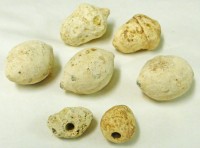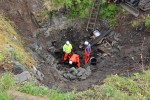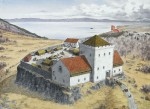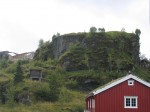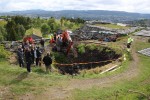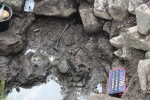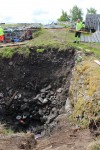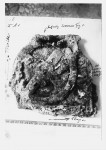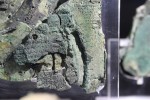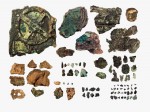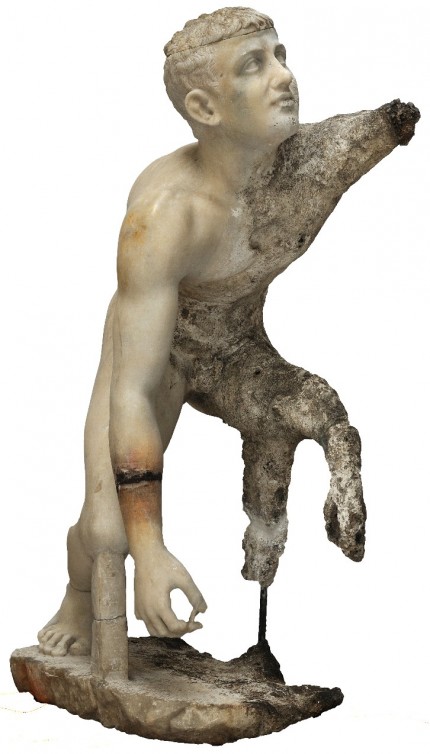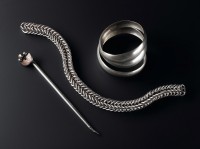 In 1838, a Pictish hoard of silver was unearthed on the grounds of Ley Farm near Fordyce, Aberdeenshire. Two prehistoric stone circles, Gaulcross North and Gaulcross South, were located a few hundred yards from the farmhouse, and the hoard was discovered a few feet south of the north circle. Maybe. Found by labourers clearing the land for agricultural use by the new tenant, the silver pieces were poorly documented at the time. The precise find spot was not recorded, nor were the pieces themselves. There were vague, conflicting accounts of what was found. Some said a silver chain four feet long, assorted buckles, pins and brooches; others reported just a silver chain, pin and armlet. The stone circles were all but destroyed during the brutal clearing process (dynamite was involved), leaving just one stone standing by 1867 when the first account of the hoard was written by John Stuart. He said the artifacts were buried inside the stone circle.
In 1838, a Pictish hoard of silver was unearthed on the grounds of Ley Farm near Fordyce, Aberdeenshire. Two prehistoric stone circles, Gaulcross North and Gaulcross South, were located a few hundred yards from the farmhouse, and the hoard was discovered a few feet south of the north circle. Maybe. Found by labourers clearing the land for agricultural use by the new tenant, the silver pieces were poorly documented at the time. The precise find spot was not recorded, nor were the pieces themselves. There were vague, conflicting accounts of what was found. Some said a silver chain four feet long, assorted buckles, pins and brooches; others reported just a silver chain, pin and armlet. The stone circles were all but destroyed during the brutal clearing process (dynamite was involved), leaving just one stone standing by 1867 when the first account of the hoard was written by John Stuart. He said the artifacts were buried inside the stone circle.
The fate of whatever pieces were found was also unclear. The property owner, Sir Robert Abercromby, 5th Baronet of Birkenbog, was said to have kept the hoard. He was also said to have given some pieces to the Banff Museum (his maternal grandfather was Alexander Ogilvie, 7th Lord Banff) in Aberdeenshire or to the Antiquarian Museum in Edinburgh. The three surviving pieces of silver were in fact at the Banff for a while. They are now at the National Museum of Scotland in Edinburgh.
In 2013, the University of Aberdeen’s Northern Picts project and National Museums Scotland’s Glenmorangie Research Project combined their efforts to investigate the site in the hopes of finding out more (anything, really) about the context of the original Gaulcross Hoard. Since they didn’t know exactly where the first pieces of the hoard had been found in the 19th century, the team had to cover a great deal of ground. A geophysical survey of the site was followed by metal detector enthusiasts scanning the Gaulcross site.
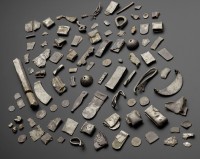 Archaeologists expected to find no more than a few fragments of silver here and there, just enough to pinpoint the find site, but on the second day metal detectorist Alistair McPherson found three Roman silver siliquae (a type of 4th century Roman silver coin that was widely cut up for use in the 5th century when fresh Roman currency was no longer imported into Britain), pieces of folded hacksilver, the endpiece of a silver strap and a silver bracelet fragment. With the tantalizing prospect of greater finds than they had expected and the daunting prospect of the field being ploughed and planted soon, the team got cracking with metal detectors and two trenches.
Archaeologists expected to find no more than a few fragments of silver here and there, just enough to pinpoint the find site, but on the second day metal detectorist Alistair McPherson found three Roman silver siliquae (a type of 4th century Roman silver coin that was widely cut up for use in the 5th century when fresh Roman currency was no longer imported into Britain), pieces of folded hacksilver, the endpiece of a silver strap and a silver bracelet fragment. With the tantalizing prospect of greater finds than they had expected and the daunting prospect of the field being ploughed and planted soon, the team got cracking with metal detectors and two trenches.
They ultimately unearthed more than 100 pieces of hacksilver chopped up from Roman and Pictish coins, jewelry, dishes, flatware, between the 4th and 6th centuries. It is the northernmost hoard of pre-Viking hacksilver ever discovered. The finds also included intact artifacts: a crescent-shaped pendant with double-loops at each end, a double-link chain, and two silver hemispheres that may have originally been part of a single piece.
 Compared to other two other hacksilver hoards found in Scotland — the Traprain Law hoard and the Norrie’s Law hoard — the discovery of so much material left in the ground after the 1838 find gave researchers new insight into the evolution of silver in Scotland since its introduction during the Roman era.
Compared to other two other hacksilver hoards found in Scotland — the Traprain Law hoard and the Norrie’s Law hoard — the discovery of so much material left in the ground after the 1838 find gave researchers new insight into the evolution of silver in Scotland since its introduction during the Roman era.
Silver was not mined in Scotland during this period, instead it had its origins in the Hacksilber from the late Roman world, as exemplified by the Traprain Law hoard. The differing compositions of individual objects in the three Scottish Hacksilber hoards will show how, through time, late Roman silver was recycled and re-cast into high-status objects that underpinned the development of elite society in the post-Roman period. During the process of recycling, the Roman silver was remade into new objects, but its origin may not have been entirely forgotten. Some of these later objects may have also directly referenced the late antique world, with items such as hand-pins showing the adaptation of late Roman military styles, both in terms of design and decorative techniques. As Gavin notes, the use of Roman models may have been intended to evoke military prowess and ostentation amongst elites in early medieval Britain and Ireland.
You can read the full report of the investigation and discoveries in the journal Antiquity.
